TOYOTA CAMRY HYBRID 2020 Warranties & Maintenance Guides (in English)
Manufacturer: TOYOTA, Model Year: 2020, Model line: CAMRY HYBRID, Model: TOYOTA CAMRY HYBRID 2020Pages: 260, PDF Size: 8.54 MB
Page 151 of 260
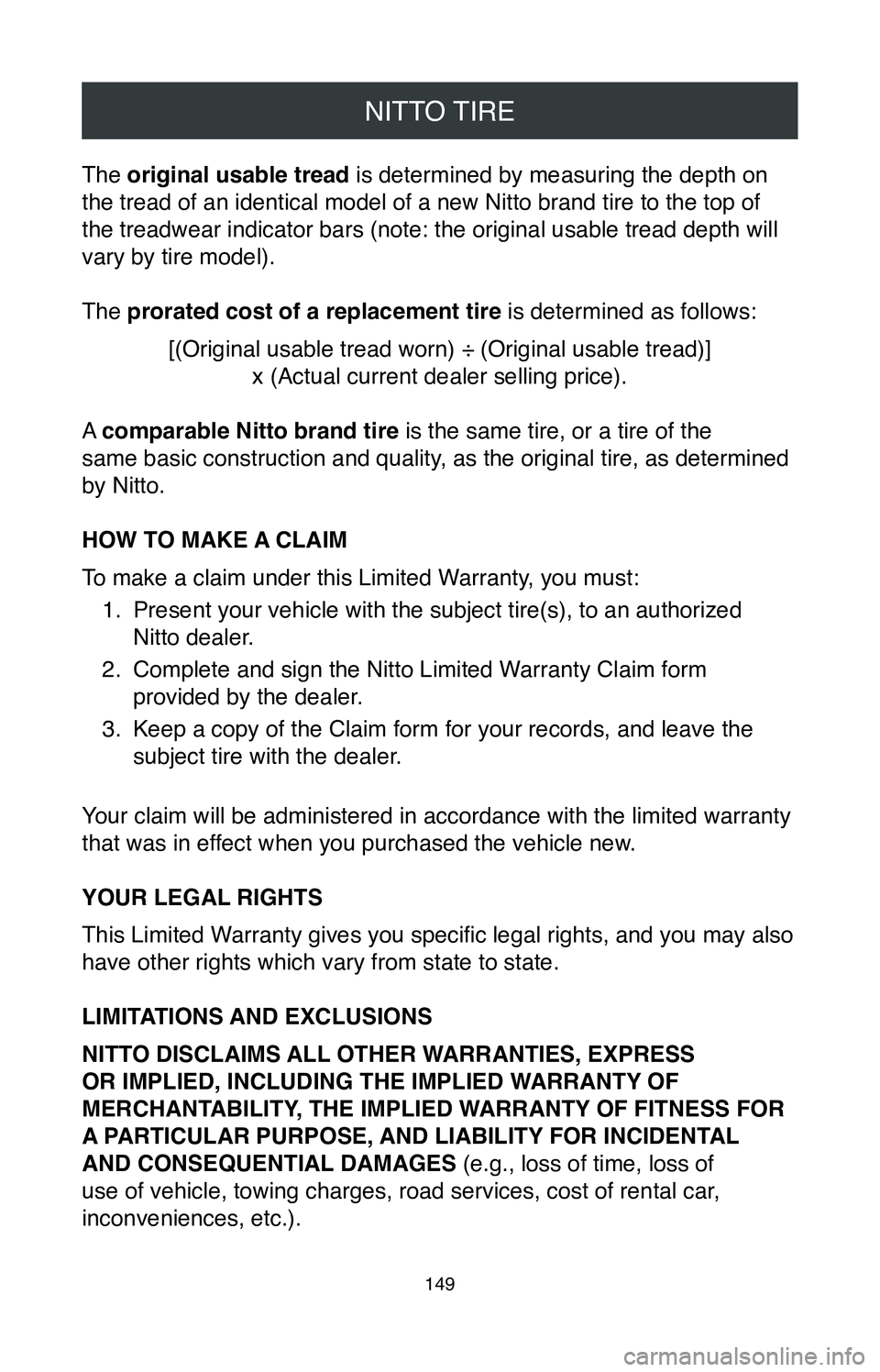
NITTO TIRE
149
The original usable tread is determined by measuring the depth on
the tread of an identical model of a new Nitto brand tire to the top of \
the treadwear indicator bars (note: the original usable tread depth will
vary by tire model).
The prorated cost of a replacement tire is determined as follows:
[(Original usable tread worn) ÷ (Original usable tread)]
x (Actual current dealer selling price).
A comparable Nitto brand tire is the same tire, or a tire of the
same basic construction and quality, as the original tire, as determined
by Nitto.
HOW TO MAKE A CLAIM
To make a claim under this Limited Warranty, you must: 1.
Present your vehicle with the subject tire(s), to an authorized
Nitto dealer.
2.
Complete and sign the Nitto Limited Warranty Claim form
provided by the dealer.
3.
Keep a copy of the Claim form for your records, and leave the
subject tire with the dealer.
Your claim will be administered in accordance with the limited warranty
that was in effect when you purchased the vehicle new.
YOUR LEGAL RIGHTS
This Limited Warranty gives you specific legal rights, and you may also
have other rights which vary from state to state.
LIMITATIONS AND EXCLUSIONS
NITTO DISCLAIMS ALL OTHER WARRANTIES, EXPRESS
OR IMPLIED, INCLUDING THE IMPLIED WARRANTY OF
MERCHANTABILITY, THE IMPLIED WARRANTY OF FITNESS FOR
A PARTICULAR PURPOSE, AND LIABILITY FOR INCIDENTAL
AND CONSEQUENTIAL DAMAGES (e.g., loss of time, loss of
use of vehicle, towing charges, road services, cost of rental car,
inconveniences, etc.).
Page 152 of 260
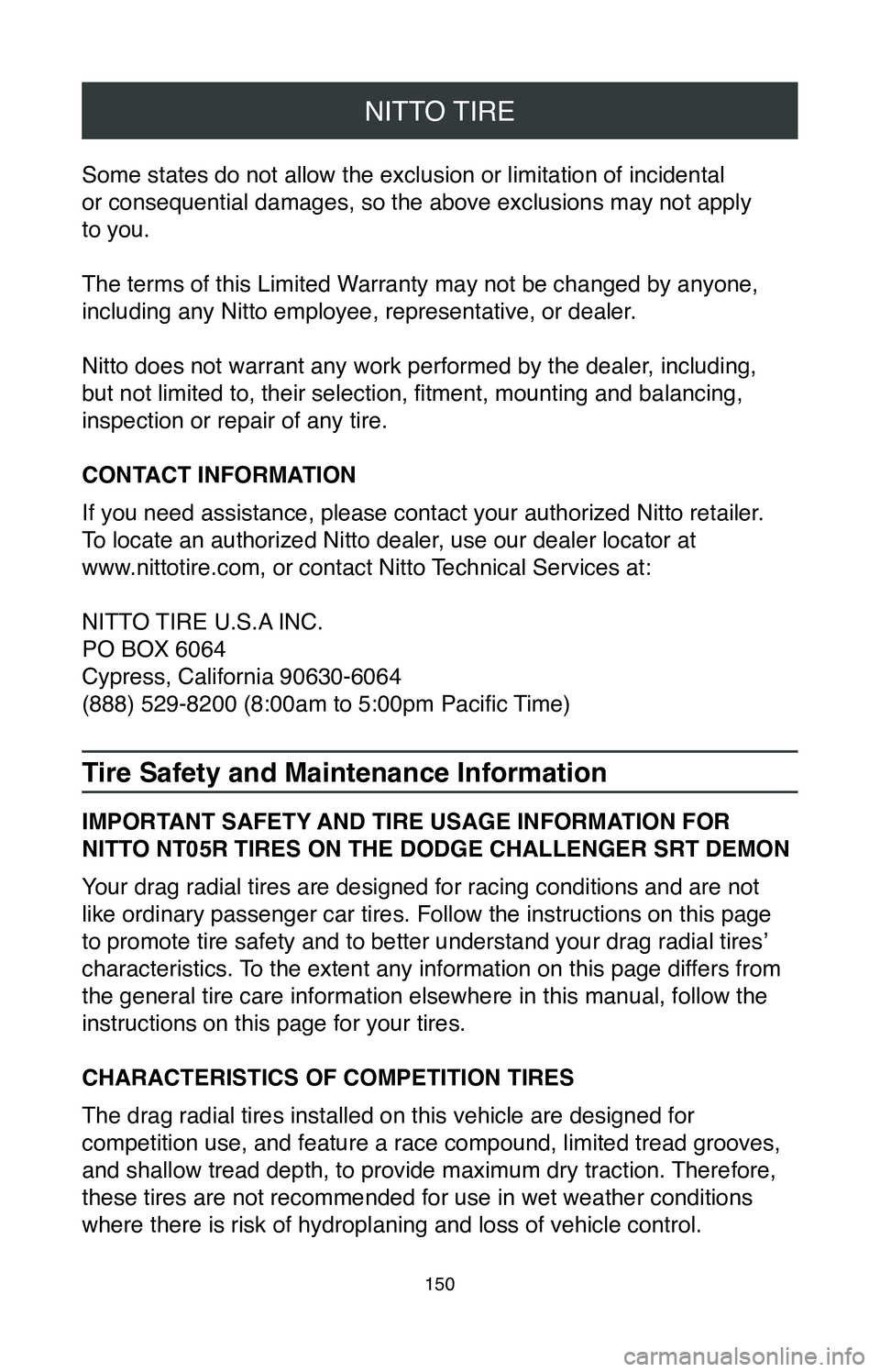
NITTO TIRE
150
Some states do not allow the exclusion or limitation of incidental
or consequential damages, so the above exclusions may not apply
to you.
The terms of this Limited Warranty may not be changed by anyone,
including any Nitto employee, representative, or dealer.
Nitto does not warrant any work performed by the dealer, including,
but not limited to, their selection, fitment, mounting and balancing,
inspection or repair of any tire.
CONTACT INFORMATION
If you need assistance, please contact your authorized Nitto retailer.
To locate an authorized Nitto dealer, use our dealer locator at
www.nittotire.com, or contact Nitto Technical Services at:
NITTO TIRE U.S.A INC.
PO BOX 6064
Cypress, California 90630-6064
(888) 529-8200 (8:00am to 5:00pm Pacific Time)
Tire Safety and Maintenance Information
IMPORTANT SAFETY AND TIRE USAGE INFORMATION FOR
NITTO NT05R TIRES ON THE DODGE CHALLENGER SRT DEMON
Your drag radial tires are designed for racing conditions and are not
like ordinary passenger car tires. Follow the instructions on this page \
to promote tire safety and to better understand your drag radial tires’
characteristics. To the extent any information on this page differs from
the general tire care information elsewhere in this manual, follow the
instructions on this page for your tires.
CHARACTERISTICS OF COMPETITION TIRES
The drag radial tires installed on this vehicle are designed for
competition use, and feature a race compound, limited tread grooves,
and shallow tread depth, to provide maximum dry traction. Therefore,
these tires are not recommended for use in wet weather conditions
where there is risk of hydroplaning and loss of vehicle control.
Page 153 of 260
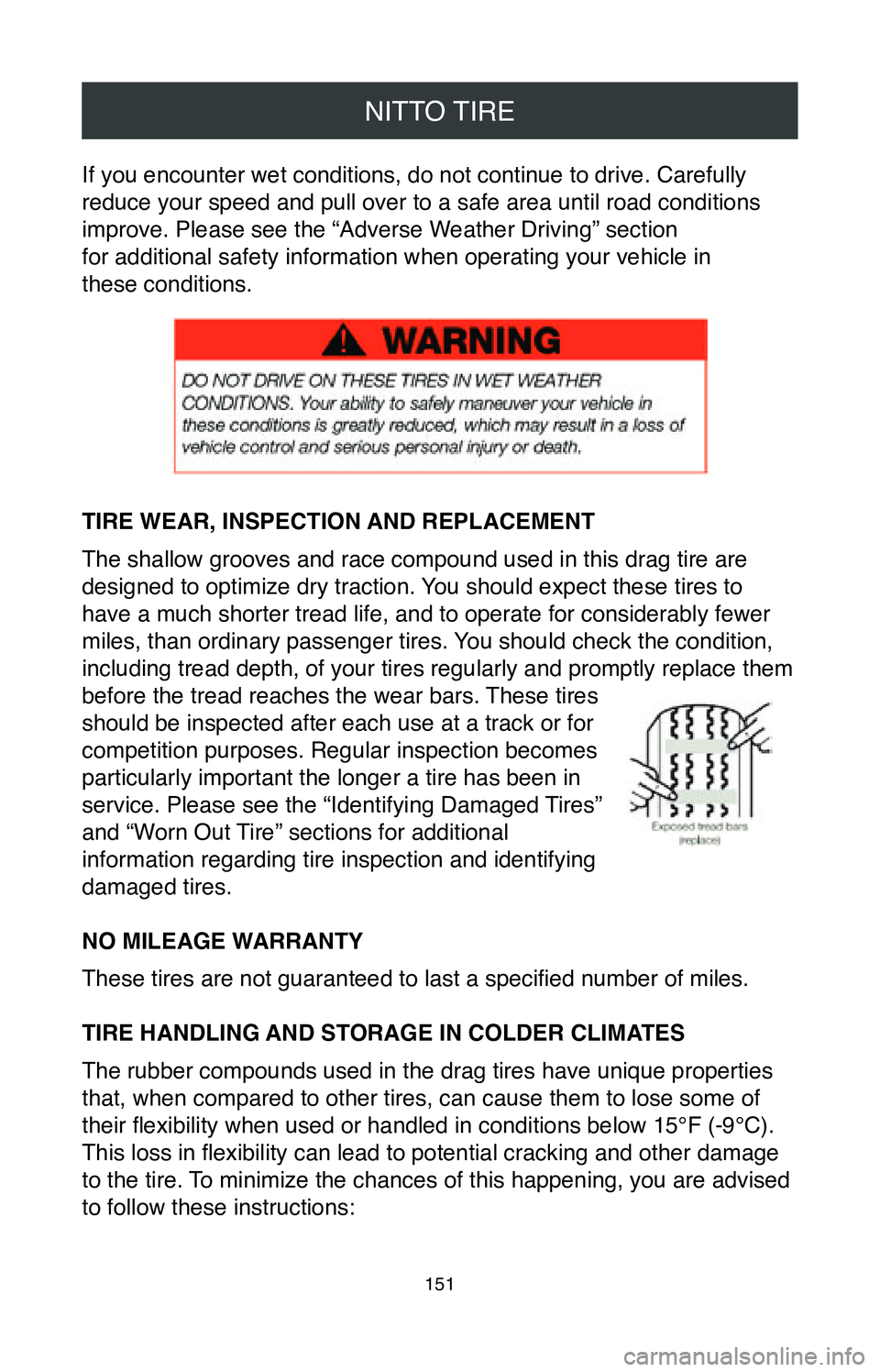
NITTO TIRE
151
If you encounter wet conditions, do not continue to drive. Carefully
reduce your speed and pull over to a safe area until road conditions
improve. Please see the “Adverse Weather Driving” section
for additional safety information when operating your vehicle in
these conditions.
TIRE WEAR, INSPECTION AND REPLACEMENT
The shallow grooves and race compound used in this drag tire are
designed to optimize dry traction. You should expect these tires to
have a much shorter tread life, and to operate for considerably fewer
miles, than ordinary passenger tires. You should check the condition,
including tread depth, of your tires regularly and promptly replace them\
before the tread reaches the wear bars. These tires
should be inspected after each use at a track or for
competition purposes. Regular inspection becomes
particularly important the longer a tire has been in
service. Please see the “Identifying Damaged Tires”
and “Worn Out Tire” sections for additional
information regarding tire inspection and identifying
damaged tires.
NO MILEAGE WARRANTY
These tires are not guaranteed to last a specified number of miles.
TIRE HANDLING AND STORAGE IN COLDER CLIMATES
The rubber compounds used in the drag tires have unique properties
that, when compared to other tires, can cause them to lose some of
their flexibility when used or handled in conditions below 15°F (-9°C).
This loss in flexibility can lead to potential cracking and other damage
to the tire. To minimize the chances of this happening, you are advised
to follow these instructions:
Page 154 of 260
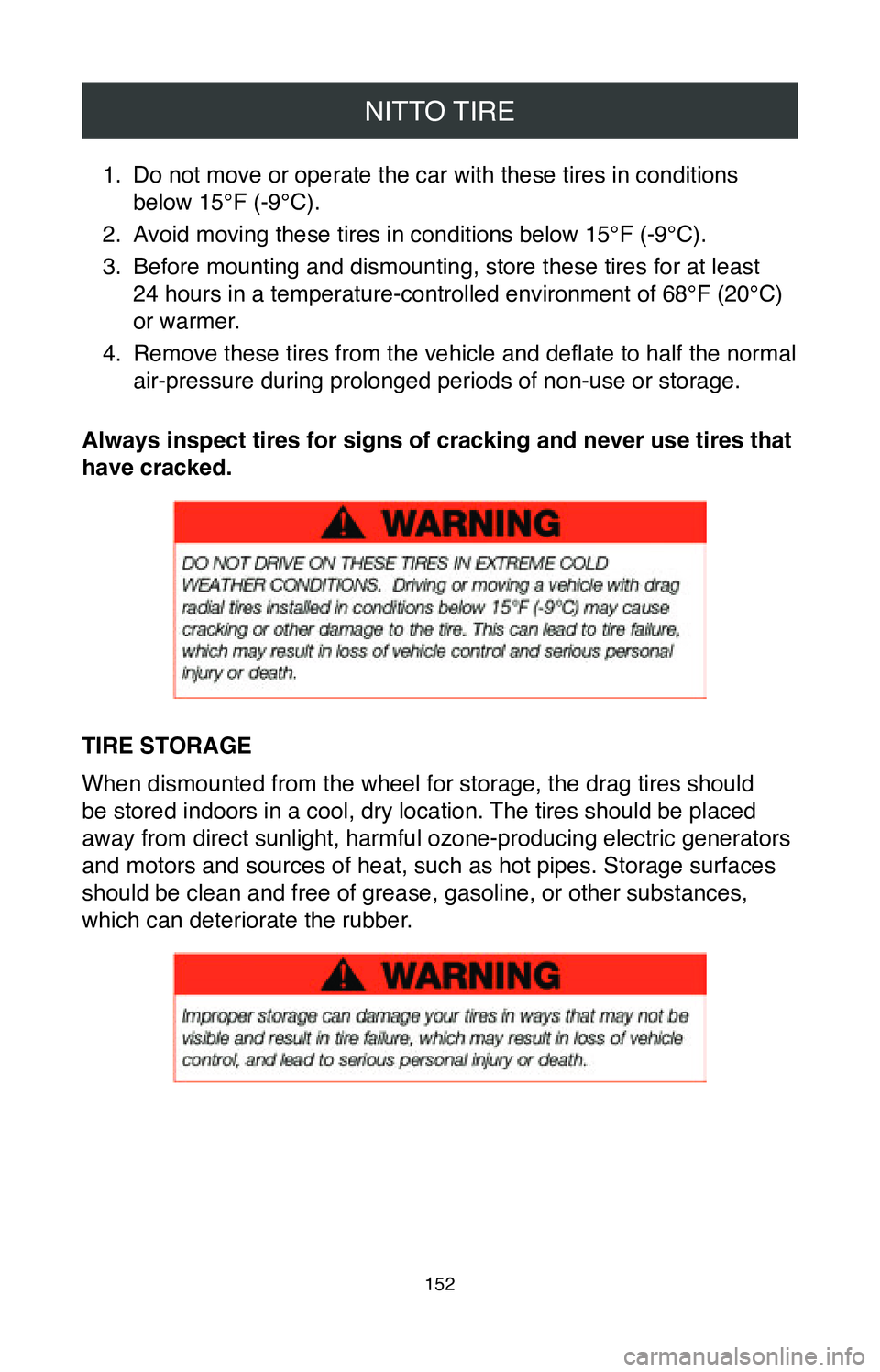
NITTO TIRE
152
1. Do not move or operate the car with these tires in conditions
below 15°F (-9°C).
2.
Avoid moving these tires in conditions below 15°F (-9°C).
3.
Before mounting and dismounting, store these tires for at least
24 hours in a temperature-controlled environment of 68°F (20°C)
or warmer.
4.
Remove these tires from the vehicle and deflate to half the normal
air-pressure during prolonged periods of non-use or storage.
Always inspect tires for signs of cracking and never use tires that
have cracked.
TIRE STORAGE
When dismounted from the wheel for storage, the drag tires should
be stored indoors in a cool, dry location. The tires should be placed
away from direct sunlight, harmful ozone-producing electric generators
and motors and sources of heat, such as hot pipes. Storage surfaces
should be clean and free of grease, gasoline, or other substances,
which can deteriorate the rubber.
Page 155 of 260
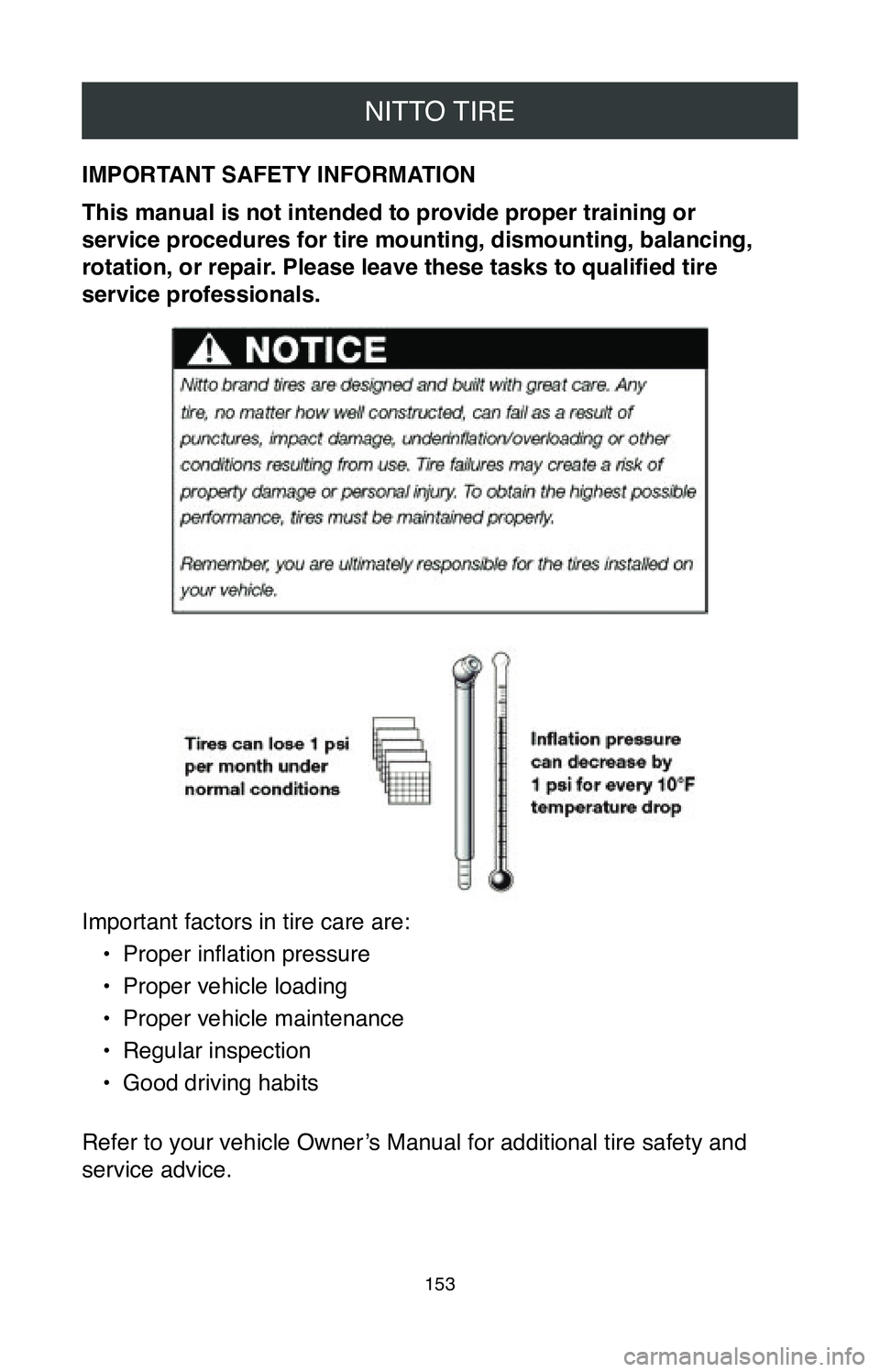
NITTO TIRE
153
IMPORTANT SAFETY INFORMATION
This manual is not intended to provide proper training or
service procedures for tire mounting, dismounting, balancing,
rotation, or repair. Please leave these tasks to qualified tire
service professionals.
Important factors in tire care are:•
Proper inflation pressure
•
Proper vehicle loading
•
Proper vehicle maintenance
•
Regular inspection
•
Good driving habits
Refer to your vehicle Owner’s Manual for additional tire safety and
service advice.
Page 156 of 260
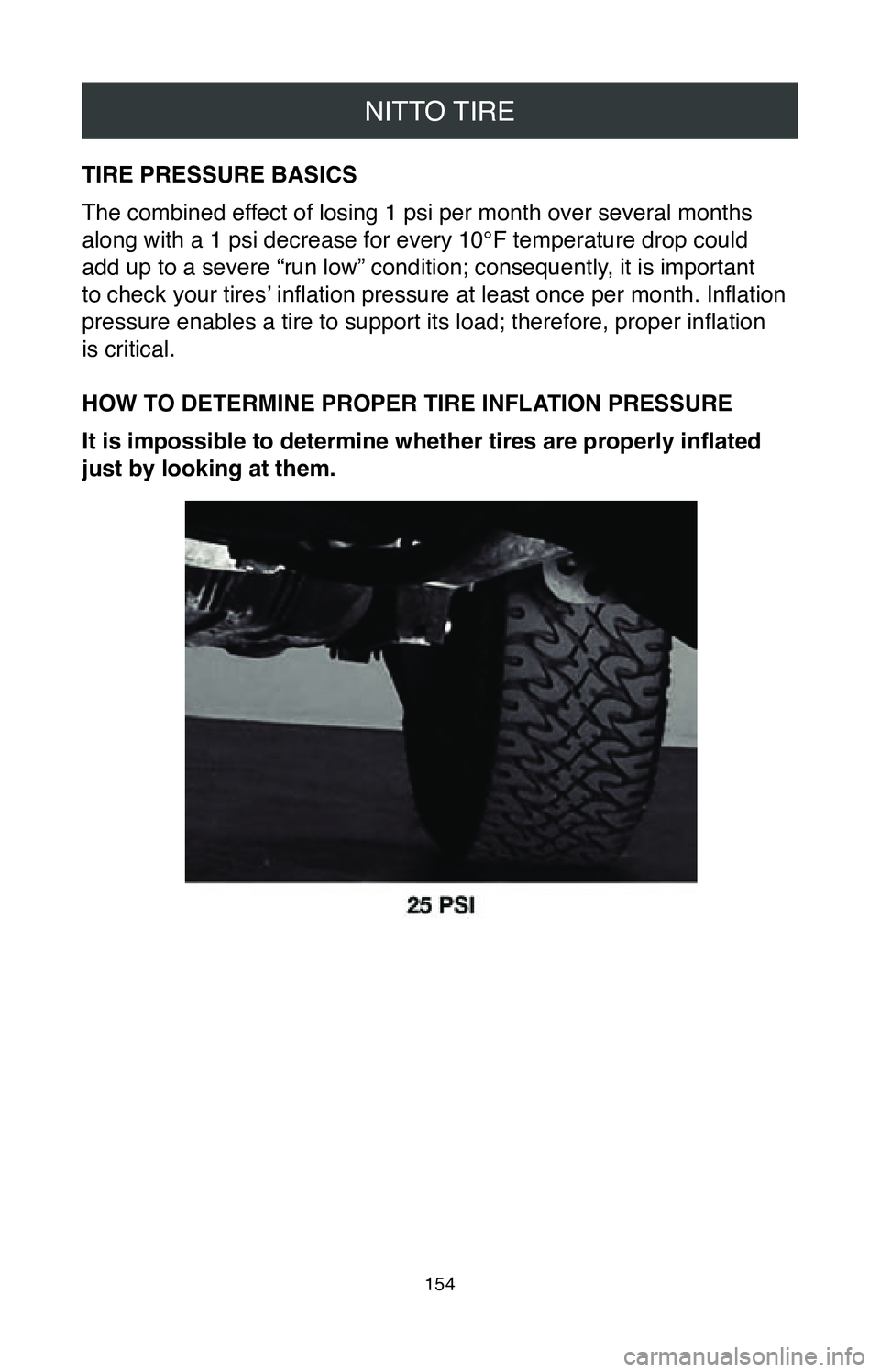
NITTO TIRE
154
TIRE PRESSURE BASICS
The combined effect of losing 1 psi per month over several months
along with a 1 psi decrease for every 10°F temperature drop could
add up to a severe “run low” condition; consequently, it is important
to check your tires’ inflation pressure at least once per month. Inflation
pressure enables a tire to support its load; therefore, proper inflation
is critical.
HOW TO DETERMINE PROPER TIRE INFLATION PRESSURE
It is impossible to determine whether tires are properly inflated
just by looking at them.
Page 157 of 260
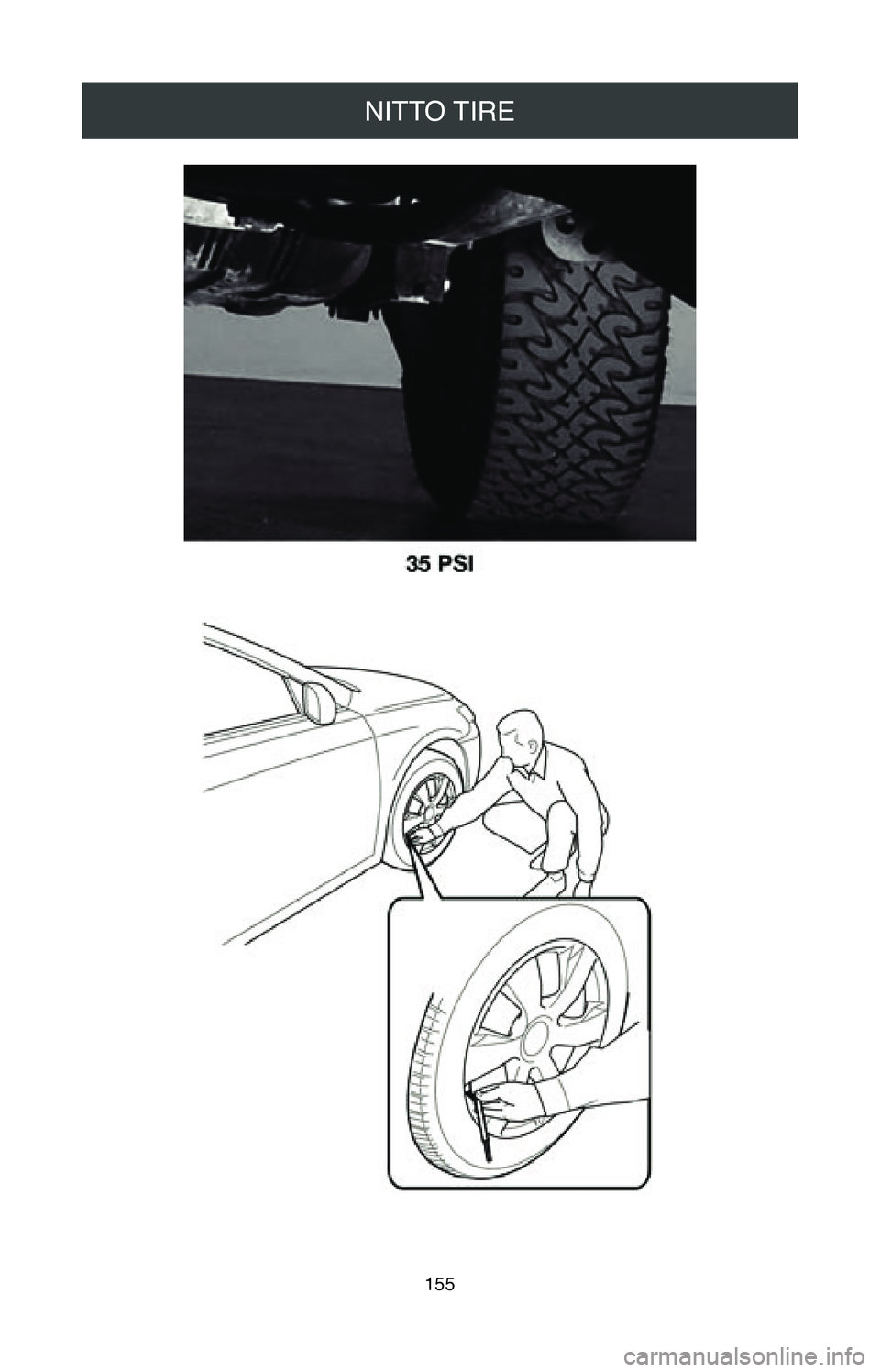
NITTO TIRE
155
Page 158 of 260
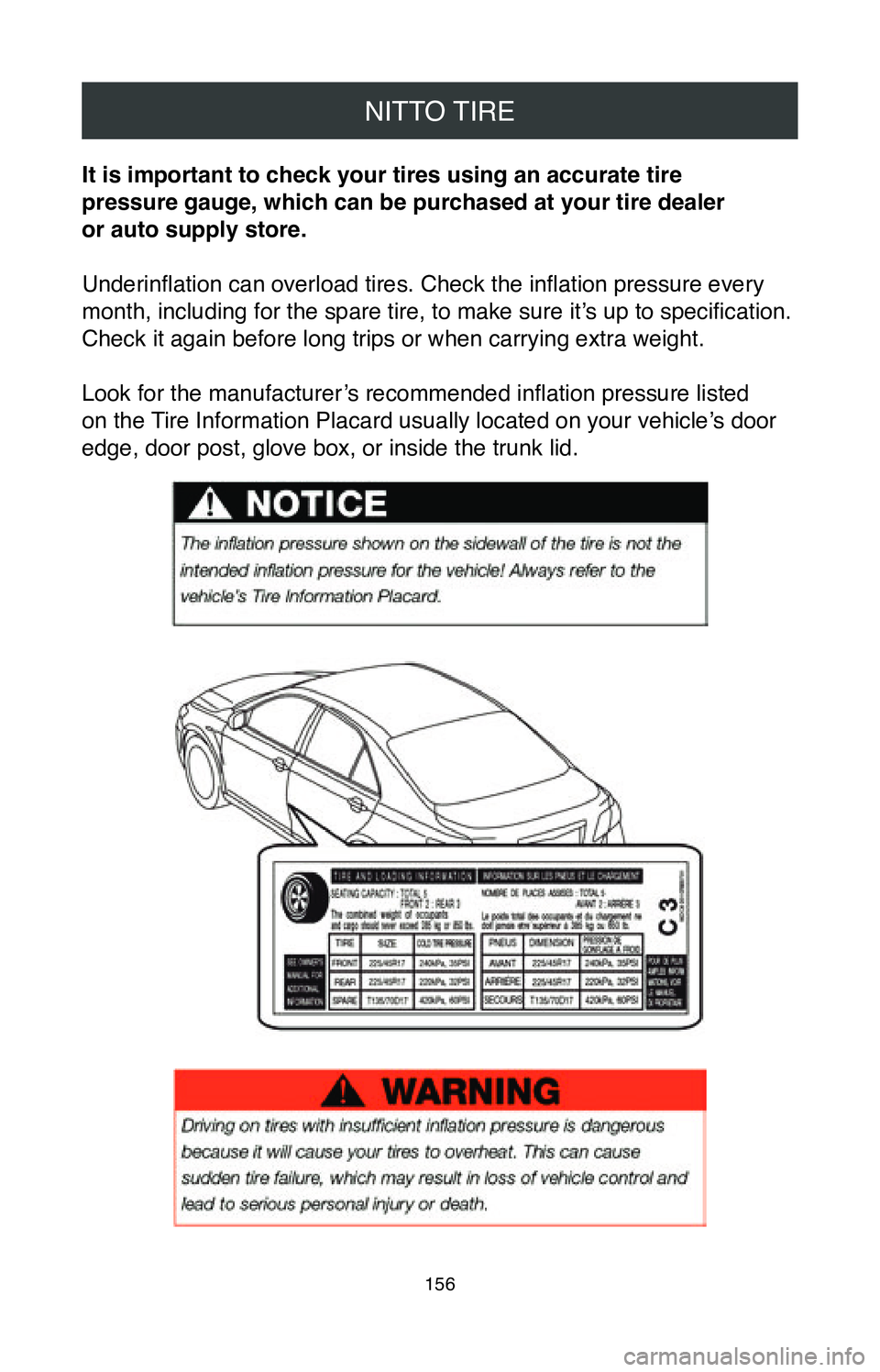
NITTO TIRE
156
It is important to check your tires using an accurate tire
pressure gauge, which can be purchased at your tire dealer
or auto supply store.
Underinflation can overload tires. Check the inflation pressure every
month, including for the spare tire, to make sure it’s up to specification.
Check it again before long trips or when carrying extra weight.
Look for the manufacturer’s recommended inflation pressure listed
on the Tire Information Placard usually located on your vehicle’s door
edge, door post, glove box, or inside the trunk lid.
Page 159 of 260
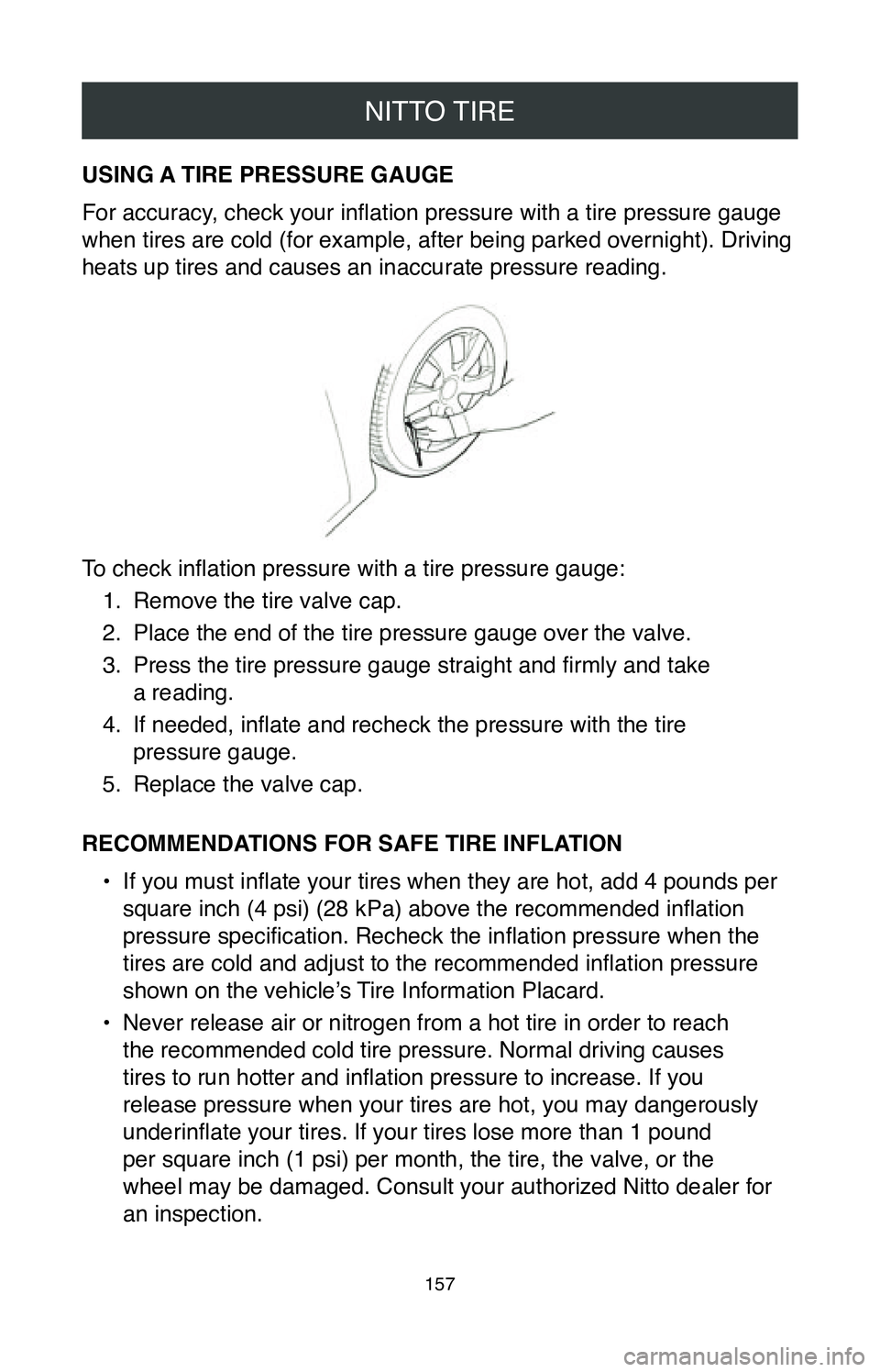
NITTO TIRE
157
USING A TIRE PRESSURE GAUGE
For accuracy, check your inflation pressure with a tire pressure gauge
when tires are cold (for example, after being parked overnight). Driving
heats up tires and causes an inaccurate pressure reading.
To check inflation pressure with a tire pressure gauge:1.
Remove the tire valve cap.
2.
Place the end of the tire pressure gauge over the valve.
3.
Press the tire pressure gauge straight and firmly and take
a reading.
4.
If needed, inflate and recheck the pressure with the tire
pressure gauge.
5.
Replace the valve cap.
RECOMMENDATIONS FOR SAFE TIRE INFLATION •
If you must inflate your tires when they are hot, add 4 pounds per
square inch (4 psi) (28 kPa) above the recommended inflation
pressure specification. Recheck the inflation pressure when the
tires are cold and adjust to the recommended inflation pressure
shown on the vehicle’s Tire Information Placard.
•
Never release air or nitrogen from a hot tire in order to reach
the recommended cold tire pressure. Normal driving causes
tires to run hotter and inflation pressure to increase. If you
release pressure when your tires are hot, you may dangerously
underinflate your tires. If your tires lose more than 1 pound
per square inch (1 psi) per month, the tire, the valve, or the
wheel may be damaged. Consult your authorized Nitto dealer for
an inspection.
Page 160 of 260
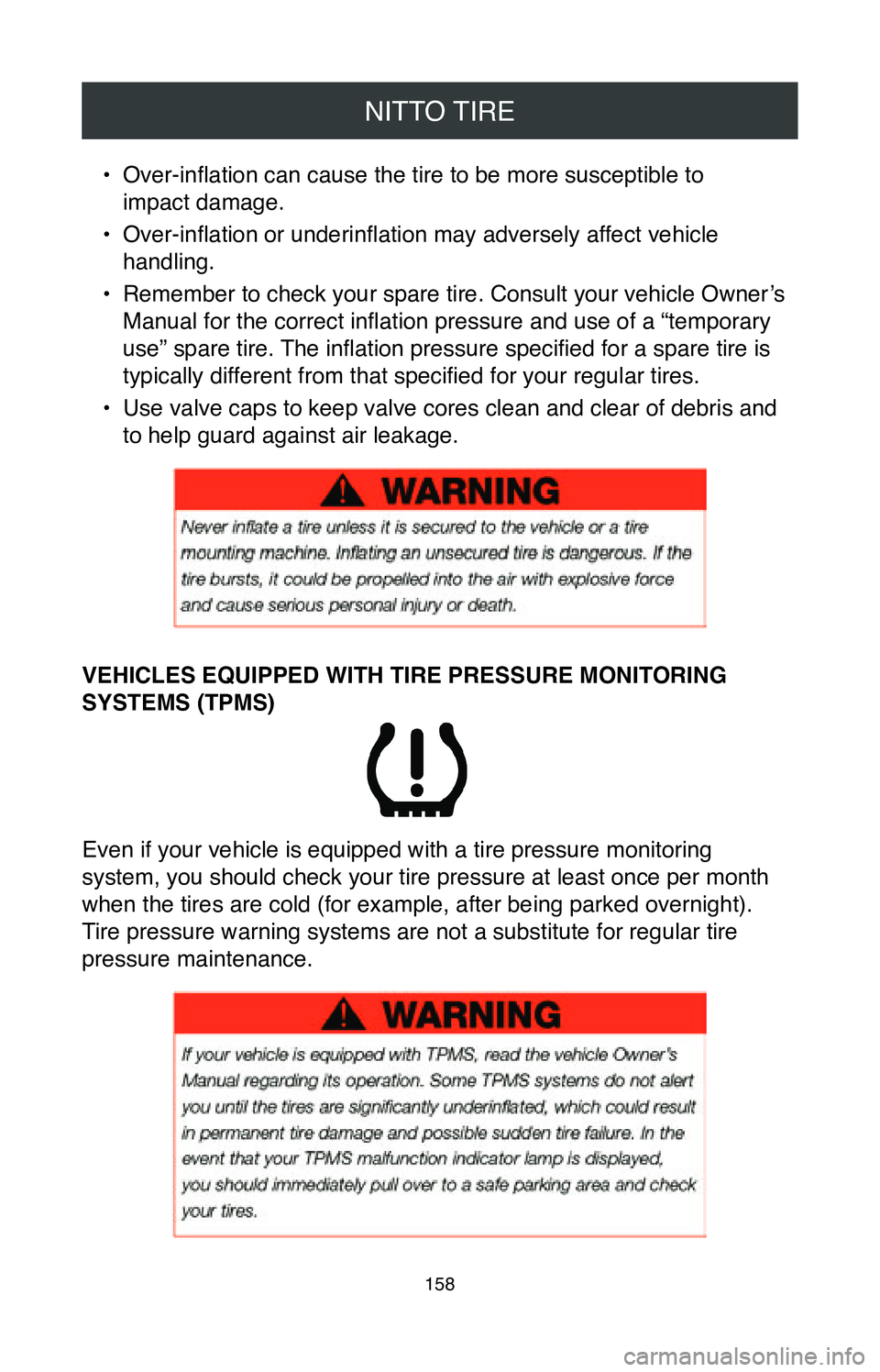
NITTO TIRE
158
• Over-inflation can cause the tire to be more susceptible to
impact damage.
•
Over-inflation or underinflation may adversely affect vehicle
handling.
•
Remember to check your spare tire. Consult your vehicle Owner’s
Manual for the correct inflation pressure and use of a “temporary
use” spare tire. The inflation pressure specified for a spare tire is
typically different from that specified for your regular tires.
•
Use valve caps to keep valve cores clean and clear of debris and
to help guard against air leakage.
VEHICLES EQUIPPED WITH TIRE PRESSURE MONITORING
SYSTEMS (TPMS)
Even if your vehicle is equipped with a tire pressure monitoring
system, you should check your tire pressure at least once per month
when the tires are cold (for example, after being parked overnight).
Tire pressure warning systems are not a substitute for regular tire
pressure maintenance.